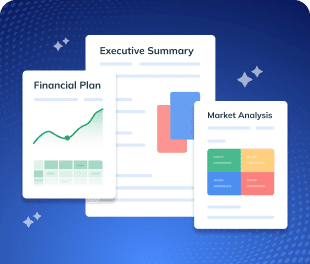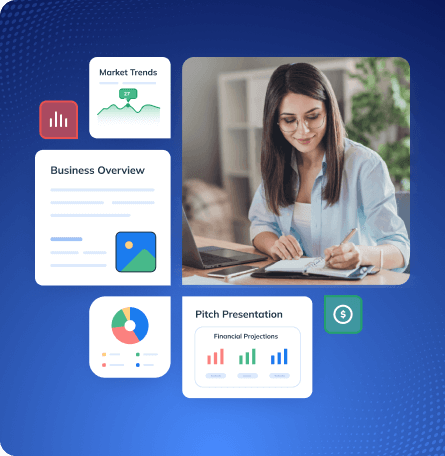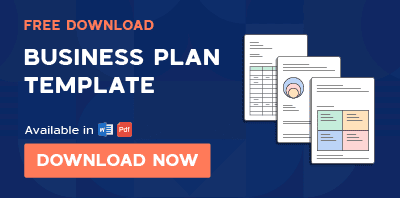Starting a freight brokerage is an exciting opportunity in today’s booming logistics sector.
With the rise of e-commferce and global trade, freight brokers are in high demand to connect shippers with reliable carriers.
However, success in this industry requires careful planning. A well-crafted business plan acts as a roadmap, helping you clarify your strategy, attract investors or partners, and stay organized in a competitive market.
Not sure how to get started?
This freight brokerage business plan template will walk you through the process.
Benefits of a freight brokerage business plan
You might wonder why it’s important to write a business plan before starting your freight brokerage. Here are some reasons why it makes sense:
- Clear strategy & direction: A business plan forces you to define your mission, freight brokerage services, target market, and future goals.
- Operational roadmap: Planning out operations, staffing, and processes in advance helps you streamline your brokerage activities.
- Market & competition insights: The research section of your plan gives you a deep understanding of the freight industry trends and competitors.
- Financial planning & funding: A detailed financial plan ensures you know your expected revenues, costs, and profitability.
- Risk management: Writing a plan encourages you to think about potential challenges and risks earlier.
In short, a freight broker business plan isn’t just a document—it’s a strategic tool that improves your chances of success.
Key elements of a freight brokerage business plan
A freight brokerage business plan follows a structured format covering all aspects of the business.
Here are the key elements (sections) you need to include, in order, as you draft your plan:
1. Executive Summary
The executive summary is the first section of your freight brokerage business plan, but it’s often written last.
This section provides a concise snapshot of your entire plan, giving readers a quick understanding of your freight brokerage and its potential. Think of it as your business’s elevator pitch in written form.
In 1–2 pages, summarize the key points from each section of your plan. Here’s what to do:
- Introduce your freight brokerage with its name and location, and briefly describe what services you offer.
- Highlight your target market. Who are your target customers? Mention the size or growth of the market to show opportunity.
- Also, point out what differentiates your brokerage. Do you specialize in certain industries or lanes, offer superior technology, or emphasize exceptional customer service?
In addition to that, include a quick overview of your company’s current status and goals. If you are seeking funding or a loan, the executive summary should clearly state how much capital you need and what you will use it for.
Say goodbye to boring templates
Build your business plan faster and easier with AI
Plans starting from $14/month

2. Company Overview
In the company overview, you will give a complete overview of your freight brokerage and what the company is.
Start with the basics, including your business name, what type of business it is, and when you’re launching. If you’re still in the early stages, include what’s been done so far and where you stand.
Then move to the mission statement, explaining the reason for the business and the principles you value and hold. Include a vision statement with your goals and direction.
This area should also include what services you are providing and why your customers should come to you.
Include what specific problems you solve for your clients, and describe what makes your services unique. Maybe you’ll provide 24/7 support, or maybe you use technology to manage shipments.
Make sure to include where you’re doing business—even if you don’t plan to have a retail location, consider how your people will work in relation to that location.
Finally, indicate what legal structure your business has licensed (LLC, S-corp, etc.) an owner, and if it’s worth mentioning, you could briefly describe how the business got started or highlight milestones.
Overall, this section helps readers understand your freight brokerage’s identity, setting the stage for the rest of your plan.
3. Industry and Market Research
In the market analysis section, you’ll demonstrate your understanding of the freight brokerage industry and the market you’re targeting. Investors and stakeholders will want to see that you’ve thoroughly researched industry trends, customer needs, and competitors.
A strong market analysis proves there’s real demand for your services and shows you know how to make your brokerage successful.
To start, let’s break down the industry overview, which gives a snapshot of the freight brokerage landscape.
Industry Overview
This section covers the current state and growth prospects of the freight brokerage industry, including major trends and key statistics. Highlight relevant growth rates, market volume, and any economic or regulatory factors affecting the industry’s progress.
Target Market
In this section, define your ideal customers and target niche. Outline the specific needs of your customers and estimate the overall market size. Understanding these factors shows your business is catering to a real demand.
With your market and customer in mind, the next step is to look at the competitive analysis.
Competitive Analysis
Identify your competitors, including both traditional and online brokers. Analyze their services, pricing, strengths, and weaknesses. This helps you understand the competitive landscape and allows you to explain your own competitive advantage.
Finally, perform a SWOT analysis to get a clear view of where your business stands.
SWOT Analysis
Conduct a SWOT analysis to evaluate your business’s strengths, weaknesses, opportunities, and threats, providing insight into your strategic positioning.
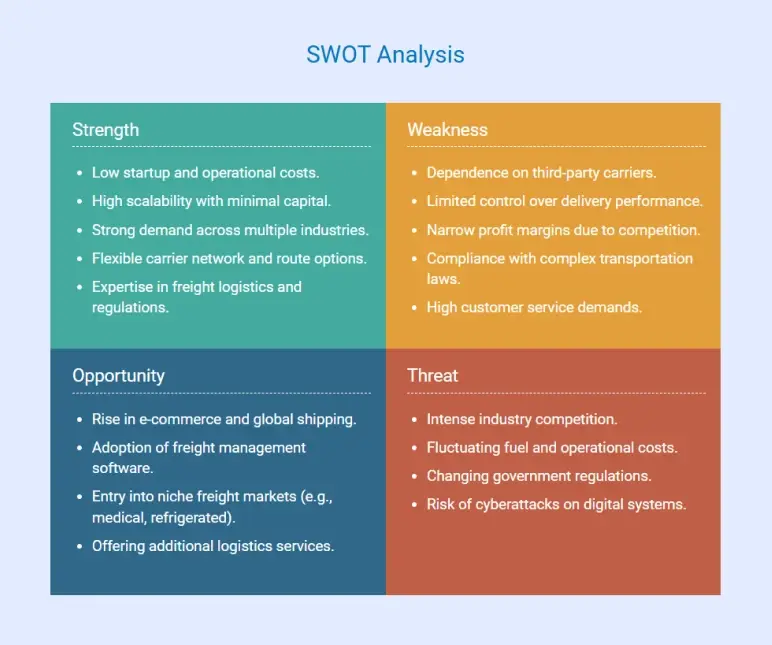
This section builds credibility by showing you’ve thoroughly researched the industry and market. It reassures stakeholders that you are prepared for challenges and ready to seize opportunities.
4. Services Description
The service description section of your business plan explains what exactly your freight brokerage offers to its clients.
While freight brokers don’t produce physical products, the “service” you provide is critically important—you’re essentially selling convenience, expertise, and logistical solutions. This section should clearly outline the scope of your brokerage services and how they meet customer needs.
This section should clearly outline the scope of your brokerage services and how they meet customer needs. So, consider including:
- Core services offered: Begin by describing the core services your freight brokerage will provide. At its most basic, a freight broker acts as the intermediary between shippers. Explain this role in terms of the value to the customer.
- Additional services/value adds: List out any additional services or value-adds you plan to offer. This could include things like freight tracking and real-time status updates, handling of paperwork, freight insurance arrangement, route optimization consulting, or even warehousing partnerships if you have those.
- Revenue model: Be sure to touch on how you will earn revenue through these services. Typically, freight brokers make money by taking a commission on each load they arrange—often, the shipper pays a fee, or the difference between what the shipper pays and what you pay the carrier is your margin.
- Service quality & reliability: Mention any processes or standards you’ll uphold. If you offer a guarantee or a high level of customer support, include that as a selling point of your service.
By the end of this section, the reader should have a clear understanding of what you offer customers and why they would choose your services over handling freight shipment themselves or using a competitor.
5. Marketing and Sales Plan
Even the best freight brokerage services won’t succeed if no one knows about them.
The marketing and sales plan section explains how you’ll attract and keep customers (shippers), and show them why they should choose your brokerage over others.
These marketing channels will help you get the word out, bring in leads, and turn them into loyal customers.
Marketing channels
Here are the key channels you’ll use to build awareness and generate leads.
- Invest in a professional website and optimize for relevant searches.
- Use pay-per-click ads on Google and targeted ads on LinkedIn to generate leads.
- Attend trade shows, conferences, and build relationships for word-of-mouth referrals.
- Use email campaigns, cold calling, or in-person visits to potential customers.
- Increase visibility through LinkedIn and logistics forums/groups by sharing industry news and tips.
Sales strategy
This section outlines how you’ll turn prospects into clients and build long-lasting relationships with them.
- Provide rate quotes to interested shippers and follow up to win their business.
- Consider offering an introductory discount for first-time customers or tiered pricing for high-volume clients.
- Provide excellent customer service, periodic check-ins, and performance reports to maintain relationships.
- Market your brokerage to qualified carriers to expand your network, ensuring you can scale as you gain more shipper clients.
By detailing your marketing and sales plan, you assure readers that you not only have a great service to offer but also a concrete plan to bring in revenue.
6. Operations Plan
The operations plan is where you outline how your freight brokerage will function on a daily basis. This section covers the practical details of running the business—the processes, tools, and resources required to deliver your services efficiently.
A well-thought-out operations plan reassures readers that you have a handle on the logistics of your company’s inner workings.
Here are a few operational details to consider for your freight brokerage:
- Shipment workflow: Outline the step-by-step process for handling shipments, from receiving a client request to final delivery and invoicing.
- Key resources & tools: Mention platforms like TMS (Transportation Management System) or brokerage software for managing loads and tracking shipments, along with communication tools for client interactions.
- Operational team: Describe team roles and clarify responsibilities, including any extended-hour operations.
- Compliance & regulations: Confirm necessary FMCSA authority, maintain the surety bond, and carry the required insurance, along with a detailed carrier vetting process.
- Resources & budgeting: List major expenses like software, office space, salaries, bonding, and equipment needs.
- Partnerships & suppliers: Discuss carrier agreements, load boards, factoring companies, and any outsourced services like after-hours dispatch or bookkeeping.
- Scaling operations: Address plans for scaling, including how TMS can handle increased volume and when to hire additional staff.
By detailing the operations plan, you show that your freight brokerage is well-prepared to handle the logistics and regulatory aspects of running the business.
7. Management Team
Investors and lenders often say they invest in people as much as in ideas. The management team section is your opportunity to showcase the individuals who will drive the success of your freight brokerage.
In this section, you’ll need to introduce your team, highlight their relevant experience and skills, and demonstrate why they’re capable of executing the business plan effectively.
Start by describing the team members and their roles, explaining what their contributions will be. If you’re starting small, explain how, at the beginning, you’ll take on multiple roles, but later on, add other people as you expand.
For each important individual, provide a short description. Emphasize their credentials, such as experience managing freight or dealing with customers, and how their skills will benefit the business. Be specific and clear about divisions of work.
You can even illustrate responsibility within a company by using an organizational chart, which depicts hierarchical relationships between different segments of the business.
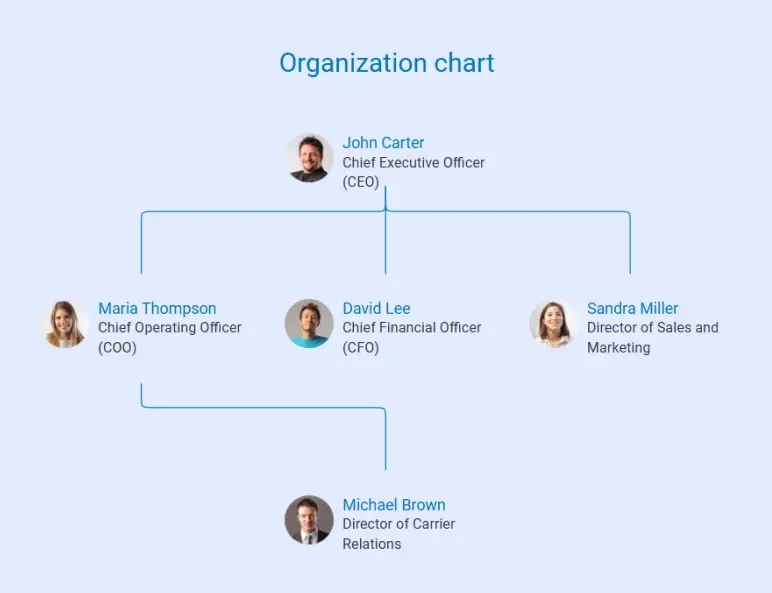
If there are any co-founders or investors, detail the division of shares among them. Also, feel free to add any other advisors or mentors who openly influence the direction of the company.
This is the section where your team demonstrates clearly that they possess the right set of skills and dedication that will make the business succeed. It doesn’t matter how little the team is; make sure that their commitment and dedication to win are well articulated.
8. Financial Plan
The financial plan is one of the most important parts of your freight brokerage business plan. It takes all your ideas and turns them into numbers, showing how your business will do financially over the next few years.
This section will show if your business can make money and stay profitable, which is something investors or lenders will pay close attention to.
It might feel a bit tricky, but with a simple approach, you can put together a strong financial plan for your business.
Here’s what you should include in your financial plan:
- Revenue model
- Startup costs & fixed expenses
- Profit and loss statement
- Cash flow & working capital
- Balance sheet
- Break-even analysis
- Risk analysis & assumptions
If you need funding, mention how much you’ll need and how the capital will be allocated.
To further illustrate this, insert a funding chart that visually represents your funding sources, projections, and how capital will be allocated to ensure business growth and sustainability.
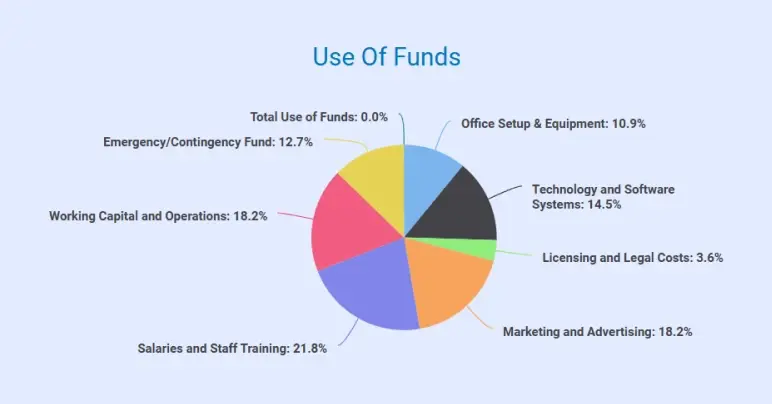
It’s important to convey that financial planning is an ongoing process, not a one-time task, which will help build confidence.
After all, as the saying goes, “numbers don’t lie”—a well-prepared financial plan demonstrates the seriousness and potential of your freight brokerage. And remember, poor financial planning is one of the top reasons startups fail.
9. Appendix
The appendix is the final section of your business plan, and it serves as a repository for any additional information or documents that support your plan but are too detailed to include in the main sections.
In the appendix, include any materials that can strengthen your case or provide backup for claims made in the plan.
Some common items to put in a freight brokerage business plan appendix are:
- Granular spreadsheets and monthly projections to complement the summary in the financial plan.
- Full resumes or CVs of yourself and key managers to prove your qualifications.
- Contracts with potential clients, carriers, or partners that show business is lined up.
- Copies of your freight broker authority, surety bond, or proof of relevant permits.
- Customer testimonials or industry references that validate your service quality.
The appendix enhances your business plan by providing additional support for your claims. Proofread everything to ensure a logical flow and complete story of your freight brokerage, from vision to details.
A well-prepared plan not only helps you communicate but also serves as a roadmap for your business journey.
Download a free freight brokerage business plan template
Writing a business plan can be overwhelming, but you don’t have to start from scratch. Download our free freight brokerage business plan template in PDF to get started.
This ready-to-use template follows the structure from this guide and includes pre-written content and financial frameworks tailored for a freight brokerage. Customizing it saves time and ensures you cover all crucial sections.
The Quickest Way to turn a Business Idea into a Business Plan
Fill-in-the-blanks and automatic financials make it easy.
Conclusion
We’ve covered all the key elements of a freight brokerage business plan, from your services and operations to marketing and financial projections. You also have access to a free sample plan to help guide you through the writing process.
However, if you’d prefer to skip the formatting and focus on your business, Upmetrics can help.
It’s an AI-powered tool that simplifies business planning, from financial forecasts to market research. It helps you generate an investor-ready plan in just a few minutes.
Don’t wait! Try Upmetrics today and turn your freight brokerage vision into a successful business.
